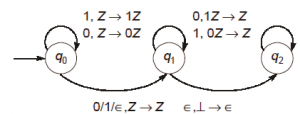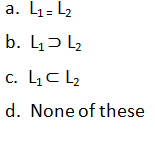Context free languages and Push-down automata
Question 21
The language accepted by a Pushdown Automation in which the stack is limited to 10 items is best described as
Question 23
Consider the NPDA 〈Q = {q0, q1, q2}, Σ = {0, 1}, Γ = {0, 1, ⊥}, δ, q0, ⊥, F = {q2}〉, where (as per usual convention) Q is the set of states, Σ is the input alphabet, Γ is stack alphabet, δ is the state transition function, q0 is the initial state, ⊥ is the initial stack symbol, and F is the set of accepting states, The state transition is as follows:
 Which one of the following sequences must follow the string 101100 so that the overall string is accepted by the automaton?
Which one of the following sequences must follow the string 101100 so that the overall string is accepted by the automaton?
 Which one of the following sequences must follow the string 101100 so that the overall string is accepted by the automaton?
Which one of the following sequences must follow the string 101100 so that the overall string is accepted by the automaton?Question 24
Which of the following languages are context-free?
L1 = {ambnanbm ⎪ m, n ≥ 1}
L2 = {ambnambn ⎪ m, n ≥ 1}
L3 = {ambn ⎪ m = 2n + 1}
Question 26
If we use internal data forwarding to speed up the performance of a CPU (R1, R2 and R3 are registers and M[100] is a memory reference), then the sequence of operations
[caption width="800"] [/caption]
[/caption]Question 27
Question 29
Let LD be the set of all languages accepted by a PDA by final state and LF the set of all languages accepted by empty stack. Which of the following is true?


Question 30
Consider the pushdown automaton (PDA) below which runs over the input alphabet (a, b, c). It has the stack alphabet {Z0, X} where Z0 is the bottom-of-stack marker. The set of states of the PDA is (s, t, u, f} where s is the start state and f is the final state. The PDA accepts by final state. The transitions of the PDA given below are depicted in a standard manner. For example, the transition (s, b, X) → (t, XZ0) means that if the PDA is in state s and the symbol on the top of the stack is X, then it can read b from the input and move to state t after popping the top of stack and pushing the symbols Z0 and X (in that order) on the stack.
(s, a, Z0) → (s, XXZ0)
(s, ϵ, Z0) → (f, ϵ)
(s, a, X) → (s, XXX)
(s, b, X) → (t, ϵ)
(t, b, X) → (t,.ϵ)
(t, c, X) → (u, ϵ)
(u, c, X) → (u, ϵ)
(u, ϵ, Z0) → (f, ϵ)
The language accepted by the PDA is
(s, a, Z0) → (s, XXZ0)
(s, ϵ, Z0) → (f, ϵ)
(s, a, X) → (s, XXX)
(s, b, X) → (t, ϵ)
(t, b, X) → (t,.ϵ)
(t, c, X) → (u, ϵ)
(u, c, X) → (u, ϵ)
(u, ϵ, Z0) → (f, ϵ)
The language accepted by the PDA is
There are 93 questions to complete.
Last Updated :
Take a part in the ongoing discussion

